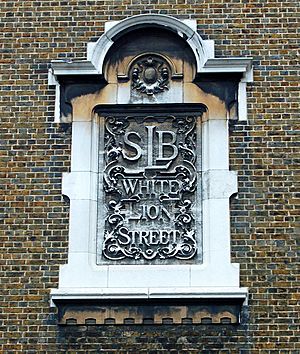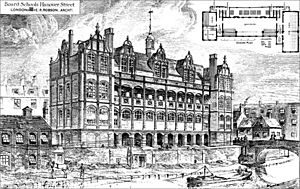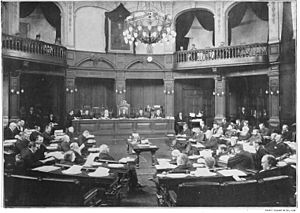London School Board facts for kids
The School Board for London, often called the London School Board (LSB), was a very important group in London's history. It was the first time people across all of London could directly vote for a group that would help run their city.
This board was created because of a new law called the Elementary Education Act 1870. This law was the first to say that all children in England and Wales should go to school. It set up elected school boards in different areas. These boards could build and run elementary schools if there weren't enough schools already. They could also make sure children actually went to school. For London, the School Board covered the whole area that is now known as Inner London.
Between 1870 and 1904, the London School Board was the biggest provider of education in London. The schools and rules they created had a huge impact on London's education system, even long after the board was closed down.
Who Was on the Board?
The entire board was elected every three years. The very first elections happened in November 1870. The LSB started with 49 members who were elected from ten different areas across London. Over time, the number of members grew to 55 by 1885.
The way people voted for the LSB was quite new for its time.
- First, the 1870 election was the first big election in Britain to use a secret ballot. This meant people could vote without anyone knowing who they chose.
- Second, they used a system called cumulative voting. This meant voters had a number of votes equal to the number of seats available in their area. They could use all their votes on just one candidate if they wanted to. This helped smaller groups or interests get their chosen person elected.
The London School Board had a very wide range of responsibilities for an elected group in Britain at that time. What was really special was that women were allowed to vote for the school boards, just like men. They could also run for election! In the first election in 1870, three women ran: Elizabeth Garrett, who got the most votes, Emily Davies, who also won, and Maria Georgina Grey. Many other notable women were elected in later years, like Florence Fenwick Miller and Helen Taylor.
Many famous people wanted to be part of the LSB. This shows how important the board was. Some well-known figures included the scientist Thomas Huxley and Lord Lawrence, who was the board's first chairman. Being on the board also helped start the careers of many politicians, such as Charles Reed and William Henry Smith.
What Did the Board Do?
The main goal of the board was to make sure there were enough school places for London's poorest children. At first, they thought they would need places for about 100,000 children. The LSB decided to build modern, high-quality schools. They also made it a rule that parents had to send their children to school. Even though it wasn't a national law until 1880, the board made a local rule in 1871 that children aged five to thirteen had to go to school.
The LSB was very successful in its goals. They often found it hard to keep up with how many families wanted to send their children to their schools. For example, by the late 1880s, the board was providing school places for over 350,000 children! This big increase was often because the board's schools were much better than private or charity schools.
The board built more than 400 schools across London. A key person in this was Edward Robert Robson, who was the board's first main architect. He designed many of the school buildings. The board wanted their schools to look good and improve the areas where they were built. Even though some people criticized the style of these schools at the time, they were usually strong and practical buildings. Many schools built during this period are still used today!
Why Did the Board Close?
Even though the school boards had done a great job getting more children into schools, some people thought they had too many rules and cost too much money. Because of this, the boards were closed down by the Education Act 1902. New groups called local education authorities took over their job.
In London, the London County Council (LCC) had been set up in 1889. In 1904, the LCC took over the responsibility for education in London from the LSB. The London School Board had its last meeting on April 28, 1904, and the LCC took over on May 1st. The LCC itself was later closed in 1965. After that, the Inner London Education Authority (ILEA) managed education for the old School Board area. The ILEA was also closed in 1990, and then the local councils in Inner London became responsible for education.
See also
- Birmingham School Board
- List of former board schools in Brighton and Hove





